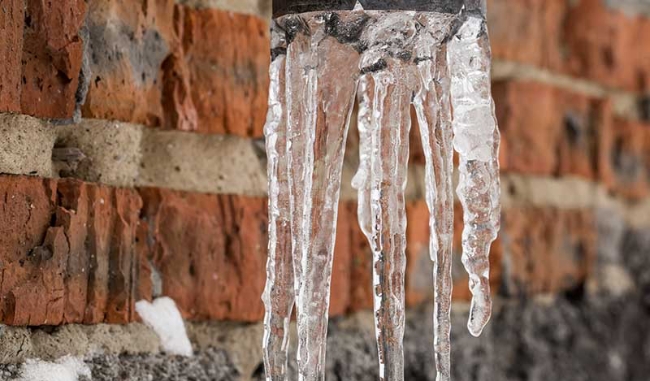Tips to Prevent Frozen Pipes in Cold Weather: Pro Guidance
Tips to Prevent Frozen Pipes in Cold Weather: Pro Guidance
Blog Article
The publisher is making several good points on the subject of Helpful Tips to Prevent Frozen Pipes this Winter overall in this great article followed below.

Winter can damage your pipes, particularly by freezing pipes. Here's exactly how to stop it from taking place and what to do if it does.
Intro
As temperature levels decrease, the threat of icy pipelines rises, possibly causing costly fixings and water damages. Understanding just how to avoid icy pipes is important for home owners in chilly environments.
Avoidance Tips
Shielding susceptible pipes
Cover pipelines in insulation sleeves or make use of warm tape to safeguard them from freezing temperatures. Focus on pipes in unheated or exterior areas of the home.
Heating methods
Keep interior spaces effectively heated up, especially locations with plumbing. Open up cupboard doors to allow warm air to distribute around pipes under sinks.
Exactly how to determine frozen pipes
Search for lowered water circulation from taps, unusual odors or sounds from pipes, and noticeable frost on subjected pipes.
Long-Term Solutions
Structural adjustments
Think about rerouting pipelines away from exterior wall surfaces or unheated locations. Add extra insulation to attics, cellars, and crawl spaces.
Updating insulation
Buy top quality insulation for pipes, attic rooms, and walls. Correct insulation assists maintain consistent temperature levels and minimizes the threat of frozen pipelines.
Securing Outdoor Plumbing
Garden hose pipes and outdoor taps
Separate and drain garden pipes before winter. Mount frost-proof spigots or cover outdoor faucets with insulated caps.
Recognizing Frozen Pipelines
What triggers pipes to freeze?
Pipelines freeze when exposed to temperature levels below 32 ° F (0 ° C) for extended durations. As water inside the pipelines ices up, it broadens, taxing the pipe wall surfaces and potentially creating them to burst.
Dangers and problems
Icy pipelines can lead to water supply disturbances, home damages, and pricey repairs. Burst pipes can flood homes and cause comprehensive structural damages.
Signs of Frozen Piping
Recognizing frozen pipelines early can stop them from breaking.
What to Do If Your Pipes Freeze
Immediate actions to take
If you suspect icy pipes, keep taps available to alleviate stress as the ice thaws. Make use of a hairdryer or towels soaked in hot water to thaw pipes slowly.
Final thought
Avoiding frozen pipes needs positive procedures and fast reactions. By understanding the reasons, indicators, and safety nets, homeowners can protect their plumbing throughout cold weather.
5 Ways to Prevent Frozen Pipes
Drain Outdoor Faucets and Disconnect Hoses
First, close the shut-off valve that controls the flow of water in the pipe to your outdoor faucet. Then, head outside to disconnect and drain your hose and open the outdoor faucet to allow the water to completely drain out of the line. Turn off the faucet when done. Finally, head back to the shut-off valve and drain the remaining water inside the pipe into a bucket or container. Additionally, if you have a home irrigation system, you should consider hiring an expert to clear the system of water each year.
Insulate Pipes
One of the best and most cost-effective methods for preventing frozen water pipes is to wrap your pipes with insulation. This is especially important for areas in your home that aren’t exposed to heat, such as an attic. We suggest using foam sleeves, which can typically be found at your local hardware store.
Keep Heat Running at 65
Your pipes are located inside your walls, and the temperature there is much colder than the rest of the house. To prevent your pipes from freezing, The Insurance Information Institute suggests that you keep your home heated to at least 65 degrees, even when traveling. You may want to invest in smart devices that can keep an eye on the temperature in your home while you’re away.
Leave Water Dripping
Moving water — even a small trickle — can prevent ice from forming inside your pipes. When freezing temps are imminent, start a drip of water from all faucets that serve exposed pipes. Leaving a few faucets running will also help relieve pressure inside the pipes and help prevent a rupture if the water inside freezes.
Open Cupboard Doors
Warm your kitchen and bathroom pipes by opening cupboards and vanities. You should also leave your interior doors ajar to help warm air circulate evenly throughout your home.

I found that blog post about Winter Plumbing Precautions: Preventing Frozen Pipes when doing a search on the search engines. Sharing is good. You just don't know, you may just be helping someone out. Thanks a lot for taking the time to read it.
Click Here Report this page